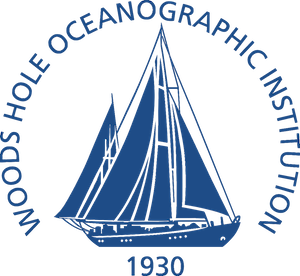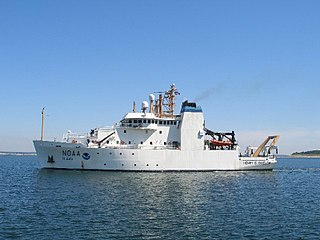
The Woods Hole Oceanographic Institution is a private, nonprofit research and higher education facility dedicated to the study of marine science and engineering.

Alvin (DSV-2) is a manned deep-ocean research submersible owned by the United States Navy and operated by the Woods Hole Oceanographic Institution (WHOI) in Woods Hole, Massachusetts. The vehicle was built by General Mills' Electronics Group in Minneapolis, Minnesota. Named to honor the prime mover and creative inspiration for the vehicle, Allyn Vine, Alvin was commissioned on 5 June 1964. The submersible is launched from the deep submergence support vessel RV Atlantis (AGOR-25), which is also owned by the U.S. Navy and operated by WHOI. The submersible has made more than 5,000 dives, carrying two scientists and a pilot, to observe the lifeforms that must cope with super-pressures and move about in total darkness, as well as exploring the wreck of Titanic. Research conducted by Alvin has been featured in nearly 2,000 scientific papers.

A research vessel is a ship or boat designed, modified, or equipped to carry out research at sea. Research vessels carry out a number of roles. Some of these roles can be combined into a single vessel but others require a dedicated vessel. Due to the demanding nature of the work, research vessels are often constructed around an icebreaker hull, allowing them to operate in polar waters.
The Florida Institute of Oceanography (FIO), located on the campus of the University of South Florida St. Petersburg, is an independent entity of the State University System of Florida that works collaboratively with 20 institutions and agencies from across the state that support marine research.

The Monterey Bay Aquarium Research Institute (MBARI) is a private, non-profit oceanographic research center in Moss Landing, California. MBARI was founded in 1987 by David Packard, and is primarily funded by the David and Lucile Packard Foundation. Christopher Scholin serves as the institute's president and chief executive officer, managing a work force of approximately 220 scientists, engineers, and operations and administrative staff.

R/P FLIP is an open ocean research platform owned by the U.S. Office of Naval Research (ONR) and operated by Scripps Institution of Oceanography. The platform is 108 meters (355 ft) long and is designed to partially flood and pitch backward 90°, resulting in only the front 17 meters (55 ft) of the platform pointing up out of the water, with bulkheads becoming decks. When flipped, most of the ballast for the platform is provided by water at depths below the influence of surface waves, hence FLIP is stable and mostly immune to wave action similar to a spar buoy. At the end of a mission, compressed air is pumped into the ballast tanks in the flooded section and the platform, which has no propulsion, returns to its horizontal position so it can be towed to a new location. The platform is frequently mistaken for a capsized ocean transport ship.

NOAAS Ronald H. Brown is a blue-water research vessel of the U.S. National Oceanic and Atmospheric Administration, she is NOAA's only Global-Class research ship.

R/V Atlantis is an oceanographic research vessel operated by the Woods Hole Oceanographic Institution as part of the University-National Oceanographic Laboratory System (UNOLS) fleet. She is the host vessel of DSV Alvin. She is named for the first research vessel operated by the Woods Hole Oceanographic Institution, R/V Atlantis for which the Space ShuttleAtlantis is also named.

RV Knorr was a research vessel formerly owned by the U.S. Navy and operated by the Woods Hole Oceanographic Institution for the U.S. research community in coordination with and as a part of the University-National Oceanographic Laboratory System (UNOLS) fleet. On March 14, 2016, Knorr was officially transferred to the Mexican Navy and renamed Rio Tecolutla. She was replaced at Woods Hole by the RV Neil Armstrong. Knorr is best known as the ship that supported researchers as they discovered the wreck of the RMS Titanic in 1985. R/V Knorr (AGOR-15) has traveled more than a million miles—the rough equivalent of two round trips to the Moon or forty trips around the Earth. Her sister ship is the RV Melville.

RV Oceanus is a Regional Class research vessel owned by the National Science Foundation, based in Newport, Oregon, and maintained and operated by Oregon State University. The ship was originally delivered to the Woods Hole Oceanographic Institution (WHOI) for operation as a part of the University-National Oceanographic Laboratory System (UNOLS) fleet in November, 1975. Oceanus made her first operational cruise in April, 1976 and operated under WHOI for thirty-six years in the Atlantic with some operations in the Mediterranean and Caribbean. The ship was scheduled to be retired in November 2011 but instead was transferred to Oregon State University, College of Earth, Ocean, and Atmospheric Sciences, for operation, replacing her sister ship, R/V Wecoma.

R/V Thomas G. Thompson (AGOR-23) is a Global-class research vessel owned by the United States Office of Naval Research and operated under a bareboat charterparty agreement by the University of Washington as part of the University-National Oceanographic Laboratory System (UNOLS) fleet.

The Hatfield Marine Science Center(HMSC) is a marine science research and education center next to Yaquina Bay of the Pacific Ocean in the U.S. state of Oregon. It is operated by Oregon State University in cooperation with five state and federal agencies co-located on site. Named after Mark Hatfield, a former U.S. Senator from Oregon, the HMSC occupies a 49-acre (20 ha) site in Newport.

Thomas G. Thompson (T-AGOR-9) was a Robert D. Conrad-class oceanographic research ship acquired by the U.S. Navy in 1965. The ship was transferred to the University of Washington for operation as part of the University-National Oceanographic Laboratory System (UNOLS) fleet on 21 September 1965. In 1988 the ship went out of UNOLS service. The ship, retaining the previous name, was designated by the Navy as IX-517 assigned to the Mare Island Naval Shipyard for general naval research. Thomas G. Thompson was later renamed Pacific Escort II with the same designation. On 7 May 1997 the Navy renamed the ship Gosport and transferred the ship to the Norfolk Naval Shipyard available for hire as a multi purpose platform from the shipyard. The ship, placed out of service and struck from the register on 27 February 2004, was sunk as part of a NATO exercise 14 November 2004.

RV Kilo Moana (AGOR-26) is a small waterplane area twin hull (SWATH) oceanographic research ship owned by the US Navy and operated by the University of Hawaii as a part of the University-National Oceanographic Laboratory System (UNOLS) fleet. She was designed to operate in coastal and blue water areas. The unique SWATH hull-form provides a comfortable, stable platform in high sea conditions.
RV Wecoma is a research vessel owned by the National Science Foundation and operated by the College of Oceanic & Atmospheric Sciences at Oregon State University (OSU) as a member of the University-National Oceanographic Laboratory System (UNOLS) fleet. It is based in Newport in the U.S. state of Oregon near OSU's Hatfield Marine Science Center. Launched in 1975, it has a maximum displacement of 1,150 long tons (1,168 t).
RV Atlantis II is a research vessel formerly operated by Woods Hole Oceanographic Institution. The ship was built in 1962. She was used as the support vessel for the Alvin submersible for many years, and retired from Woods Hole service in 1996. After a period of inactivity in New Orleans she was transferred to the travel adventure company Outlander Expeditions in 2006. In 1986 she was used by Dr. Robert Ballard as mother-ship to DSV Alvin when Ballard and team surveyed the RMS Titanic wreck for the first time. The Titanic expedition was sponsored by National Geographic.

NOAAS Henry B. Bigelow is a fisheries research vessel operated by the United States' National Oceanic Atmospheric Administration (NOAA). She is the second in a class of five new fisheries research vessels. She is named after Henry Bryant Bigelow (1879-1967), the American oceanographer, zoologist, and marine biologist who founded the Woods Hole Oceanographic Institution in Woods Hole, Massachusetts.

The Southern California Marine Institute (SCMI) is a multi-campus research facility and non-profit oceanographic institution headquartered in Terminal Island, California.

The REMUS series are autonomous underwater vehicles (AUVs) made by the Woods Hole Oceanographic Institution and designed by their Oceanographic Systems Lab (OSL). More recently REMUS vehicles have been manufactured by the spinoff company Hydroid Inc. a wholly owned subsidiary of Kongsberg Maritime. The series are designed to be low cost, they have shared control software and electronic subsystems and can be operated from a laptop computer. They are used by civilians for seafloor mapping, underwater surveying, and search and recovery as well as by several navies for mine countermeasures missions.

RV Neil Armstrong (AGOR-27) is the designation for a new oceanographic research ship, first of the Neil Armstrong-class research vessels, to be owned by the United States Navy and operated by Woods Hole Oceanographic Institution. Secretary of the Navy Ray Mabus announced on September 24, 2012 that the research vessel was to be named after Neil Armstrong, the first person to walk on the Moon and a former naval aviator who served in the Korean War.

















